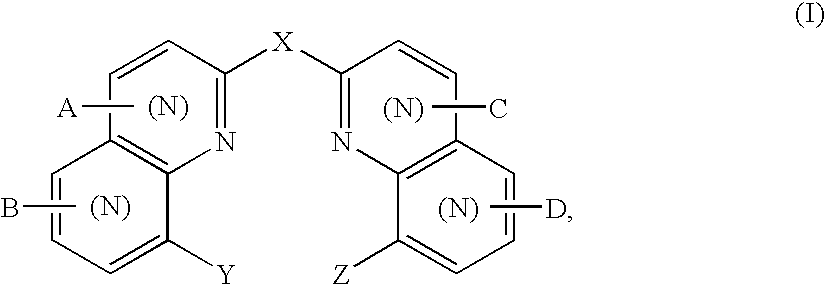Bis(hydroxyquinoline) metal complexes as bleach catalysts
a metal complex and catalyst technology, applied in metal/metal-oxide/metal-hydroxide catalysts, physical/chemical process catalysts, other chemical processes, etc., can solve the problems of unsatisfactory bleaching performance of most bleach activators at low temperatures, shift in ph that can have an unfavorable effect on bleaching performance, and lack of bleaching performan
- Summary
- Abstract
- Description
- Claims
- Application Information
AI Technical Summary
Benefits of technology
Problems solved by technology
Method used
Image
Examples
example 1
Preparation of the bisq Complexes Used
[0131][Mn3(bisq)2(L)2(OAc)2]
3 C19H15N3O2+2 Mn(OAc)2*4H2O→[Mn3(N-Me-bisq)2(L)2(OAc)2]
3 C22H21N3O2+2 Mn(OAC)2*4H2O→[Mn3(N-nBu-bisq)2(L)2(OAc)2]
[0132]Preparation of the Complexes is Achieved by Reacting the Corresponding Bisq ligand with 1.5 equivalents of manganese(II) acetate tetrahydrate in methanol.
[0133]For this, 3 mmol of the respective ligand (Fluka) is weighed, combined with 30 ml methanol or ethanol, and heated in reflux. This is followed by the addition of 1 mmol Mn(OAc)2 as a solid or a methanol solution; a suspension of an orange solid in yellowish solution forms almost immediately. After cooling to room temperature, the complex can be separated out quantitatively as an orange, finely crystalline solid.
[0134][Mn3(N-nBu-bisq)2(L)2(OAc)2]:
IR (KBr): 3039, 2964, 2799, 1616, 1589, 1559, 1497, 1469, 1441, 1386, 1373, 1332, 1288, 1214, 1132, 1288, 1214, 1132, 1100, 1046, 858, 824, 794, 744, 661, 592, 540, 514, 430 cm−1.
Comp. crystal structure:...
example 2
Test of the Mn-N-n-Bu-bisq Complex for Damage and Primary Washing Performance in the Miniaturized Washing Test
[0139]Mn-bisq complexes where R=hydrogen (bisq), n-butyl (N-n-Bu-bisq), or R=methyl (N-n-Me-bisq)
[0140]Mn-S-bisq Complex
[0141]The primary washing power and wet breaking load loss were tested in a miniaturized washing test, working with a complete liquid laundry detergent formulation. The pH values in the liquid formulation were adjusted with NaOH so that for a dispensing rate of 4.4 gal and after addition of the other additives, the respective pH existed in the washing formulation. 4.4 g / l liquid laundry detergent, 0.35 g / l H2O2, and 3.6 mg / l Mn-N-nBu-bisq were added to water at 16° dH. The cavities of the MLA were each filled with 10 ml of the washing liquor.
[0142]For primary washing performance, a cotton substrate having the respective stain was clamped in the sample container and the container was rotated in the microwave for 1 h at the indicated temperature so that the l...
example 3
Washing Tests in a Model Washing Facility
[0147]The washing test is carried out in a temperature-controllable multi-agitator apparatus.
[0148]The test vessels used are 1-liter beakers in which an apparatus is present for mechanically stirring the washing bath. The stirring mechanism is designed so that on the one hand all the beakers are stirred at the same speed, and on the other hand the stirring direction periodically changes. The washing chambers are loaded with approx. 16 g of ballast laundry and approx. 6 g of stained fabric (the fabric pieces are cut into a square shape approx. 6 cm on a side and are made of cotton). All the test fabrics are manufactured by CFT B.V. (Netherlands).
[0149]The stained fabrics involve the following bleach-relevant test substrates:
CS-103red wineCS-3red wine, agedBC-1teaBC-3teaCS-15bilberry juice
From these five test fabrics, a set of eight stained fabric pieces was assembled for the tests. This means that three stains are represented twice in the test...
PUM
| Property | Measurement | Unit |
|---|---|---|
| pH | aaaaa | aaaaa |
| particle size | aaaaa | aaaaa |
| particle size | aaaaa | aaaaa |
Abstract
Description
Claims
Application Information
 Login to View More
Login to View More - R&D
- Intellectual Property
- Life Sciences
- Materials
- Tech Scout
- Unparalleled Data Quality
- Higher Quality Content
- 60% Fewer Hallucinations
Browse by: Latest US Patents, China's latest patents, Technical Efficacy Thesaurus, Application Domain, Technology Topic, Popular Technical Reports.
© 2025 PatSnap. All rights reserved.Legal|Privacy policy|Modern Slavery Act Transparency Statement|Sitemap|About US| Contact US: help@patsnap.com



